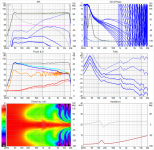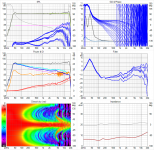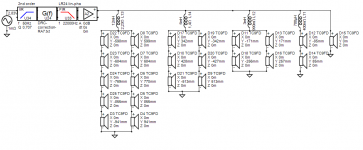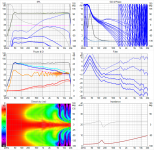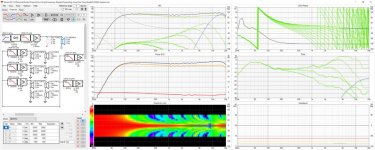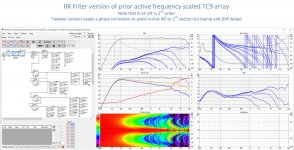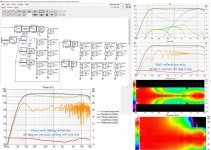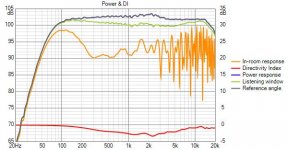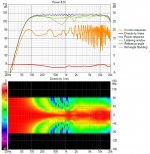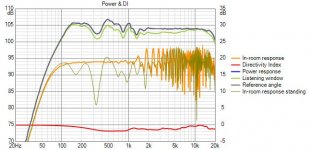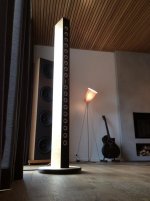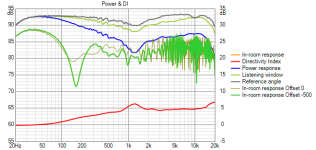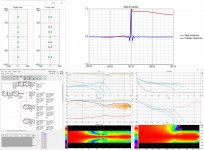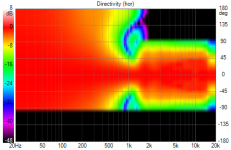On horns, I have to agree that if you have the space, they are the way to go. You need a really large horn to maintain vertical pattern control low enough to avoid a floor bounce null. And an even larger room to be able to pull the horns well out away from the walls.
The early loss of vertical pattern control was an issue with my synergy corner horns; the other was the midband narrowing because I omitted a secondary flare. But the listening experience was superb.
But the arrays are or can be great as well and take up a lot less space.
I think you are where I was on the expanding array before I put it aside. I got a nice response with a TC9 tweeter at center and then realized I needed a more robust device for the top frequency range. And robust tweeters do exist: e.g. SB29 @>100W.
Ideally you would use a tweeter in a waveguide shaped to match the TC9's horizontal directivity. With a bare tweeter, the horizontal pattern would never match the rest of the array. I never found one but realize now I could probably develop/model one in axidriver and it would likely reduce to an OS profile machined into the baffle. I think maybe if I had heard a refined array such as you are working on, I would have been more motivated to go further in that direction but I chose instead to pursue the frequency shaded array. It remains to be seen how much better a line array sounds with subtractive combining effects removed via fine frequency shading.
The early loss of vertical pattern control was an issue with my synergy corner horns; the other was the midband narrowing because I omitted a secondary flare. But the listening experience was superb.
But the arrays are or can be great as well and take up a lot less space.
I think you are where I was on the expanding array before I put it aside. I got a nice response with a TC9 tweeter at center and then realized I needed a more robust device for the top frequency range. And robust tweeters do exist: e.g. SB29 @>100W.
Ideally you would use a tweeter in a waveguide shaped to match the TC9's horizontal directivity. With a bare tweeter, the horizontal pattern would never match the rest of the array. I never found one but realize now I could probably develop/model one in axidriver and it would likely reduce to an OS profile machined into the baffle. I think maybe if I had heard a refined array such as you are working on, I would have been more motivated to go further in that direction but I chose instead to pursue the frequency shaded array. It remains to be seen how much better a line array sounds with subtractive combining effects removed via fine frequency shading.
I don't quite have results to share yet. Time is at a premium, but should have more time next week.
I am finding it instructive to model using ideal driver behavior rather than the measured response (provided kindly by nc35... thank you!). There are two schemes I am trying:
1. Sets of six drivers (I have 24 in total, not 25 like you two) plus one central tweeter. Currently simulating with just a TC9.
2. Expanding set with central tweeter, 12, 6, 4, 2, 1. This one shows promise. I am getting much smoother directivity change with this approach. See attached layout. Still very preliminary.
I definitely think a dedicated tweeter is the way to go having heard the improvement with the Fountek Neo CD 3.5H.
I was asking about directivity in your other thread, but there was something wrong with my simulation. I had added a driver but was not using it and it was totally screwing up the sim. So, removing it fixed the sim and now I do see reasonable results.
One question is about the floor and ceiling reflections. Turning them on does absolutely nothing to the results. What am I missing?
I was curious enough to try:
A quick try though with my own driver positions more or less...
The wavy orange in-room prediction shows it does suffer from some from floor and ceiling reflection (set at -6 dB for both here)...
The worry I would have is that the single tweeter is asked to do a lot!
I made the level the same as on my own sims. We see a 10 dB boost on the top end of the single tweeter, where my own sims show way less and the load is shared by 5 drivers.
My sim with similar -6 dB reflection levels...
That's what I meant with a "rugged tweeter" would be needed.
Your DI curve looks excellent though! But to get there would require something better than a TC9 as tweeter.
(by the way, I only counted 23 drivers (lol))
Attachments
Last edited:
went back in my archives and found this screenshot of my tc9 expanding array with SB26 in OSWG waveguide at center. I guess I went further with this than I recalled. I got the tweeter directivity by tracing a graph linked or posted in Augerpro's open source waveguide thread. Its a fudge as the waveguide was elliptical so I'm using horizontal directivity for vertical and very likely the CTC doesn't correspond to what is possible.
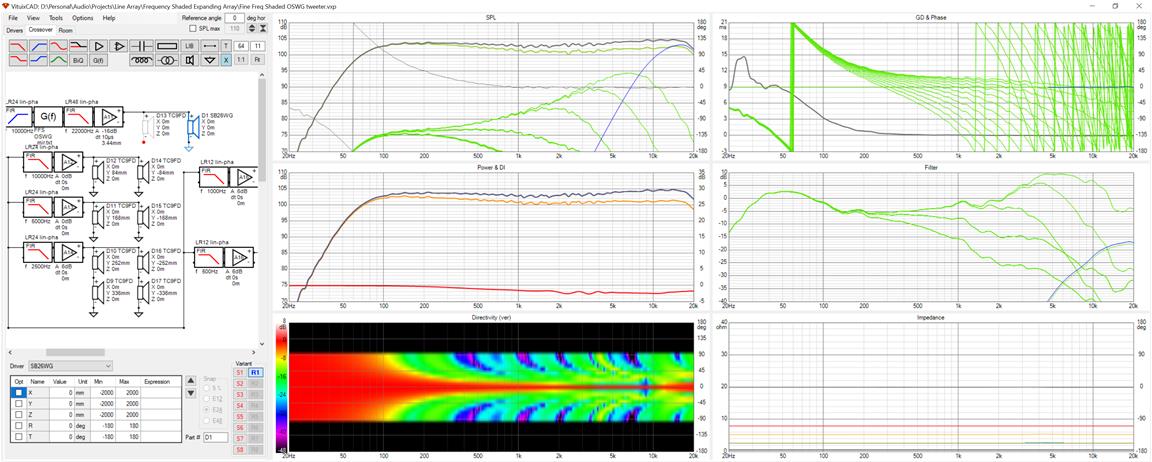
I cut the tweeter in at 10 khz, could well have gone lower, don't remember why I didn't. This was very early in my simulation marathon and I diverted onto a different path. I think the reason I quit this was I didn't have realistic waveguide directivity.
I cut the tweeter in at 10 khz, could well have gone lower, don't remember why I didn't. This was very early in my simulation marathon and I diverted onto a different path. I think the reason I quit this was I didn't have realistic waveguide directivity.
Attachments
In all fairness the listening level should be raised in my quick attempt to copy, as there is one more driver below...
It looks like the speaker load Z goes down to 2 ohms at 20 hz. not necessarily a problem, just saying
My only concern about passive filters is that their group delay adds to the delta path delay. I wonder if that is why my actively frequency shaded array has a narrower vertical pattern, which isn't necessarily a good thing if your usage model is both seated and standing listening.
I've spend a lot of time to get it narrow enough, but still keep the standing position.
There's only so much we can do, especially with passive components.
Even though the graphs on the proposal from ra7 look better in terms of DI index, the floor/ceiling influence is bigger than on my shelf shaded proposal.
My preference goes to the shelf shading in this case, as it has the most chance of working with the room. At least in my room . Plus I like the shared load better than one driver working real hard to keep up. The compromise mostly is top end performance above 10 KHz. But compared to the unshaded there should be a noticeable improvement, at least on paper. The factor that got me willing to try it is that there is a chance of improvement all across the board down to 200 Hz.
. Plus I like the shared load better than one driver working real hard to keep up. The compromise mostly is top end performance above 10 KHz. But compared to the unshaded there should be a noticeable improvement, at least on paper. The factor that got me willing to try it is that there is a chance of improvement all across the board down to 200 Hz.
There's only so much we can do, especially with passive components.
Even though the graphs on the proposal from ra7 look better in terms of DI index, the floor/ceiling influence is bigger than on my shelf shaded proposal.
My preference goes to the shelf shading in this case, as it has the most chance of working with the room. At least in my room
Last edited:
In fact, I would say the passive's delay does have an effect. Note the comment on this picture:
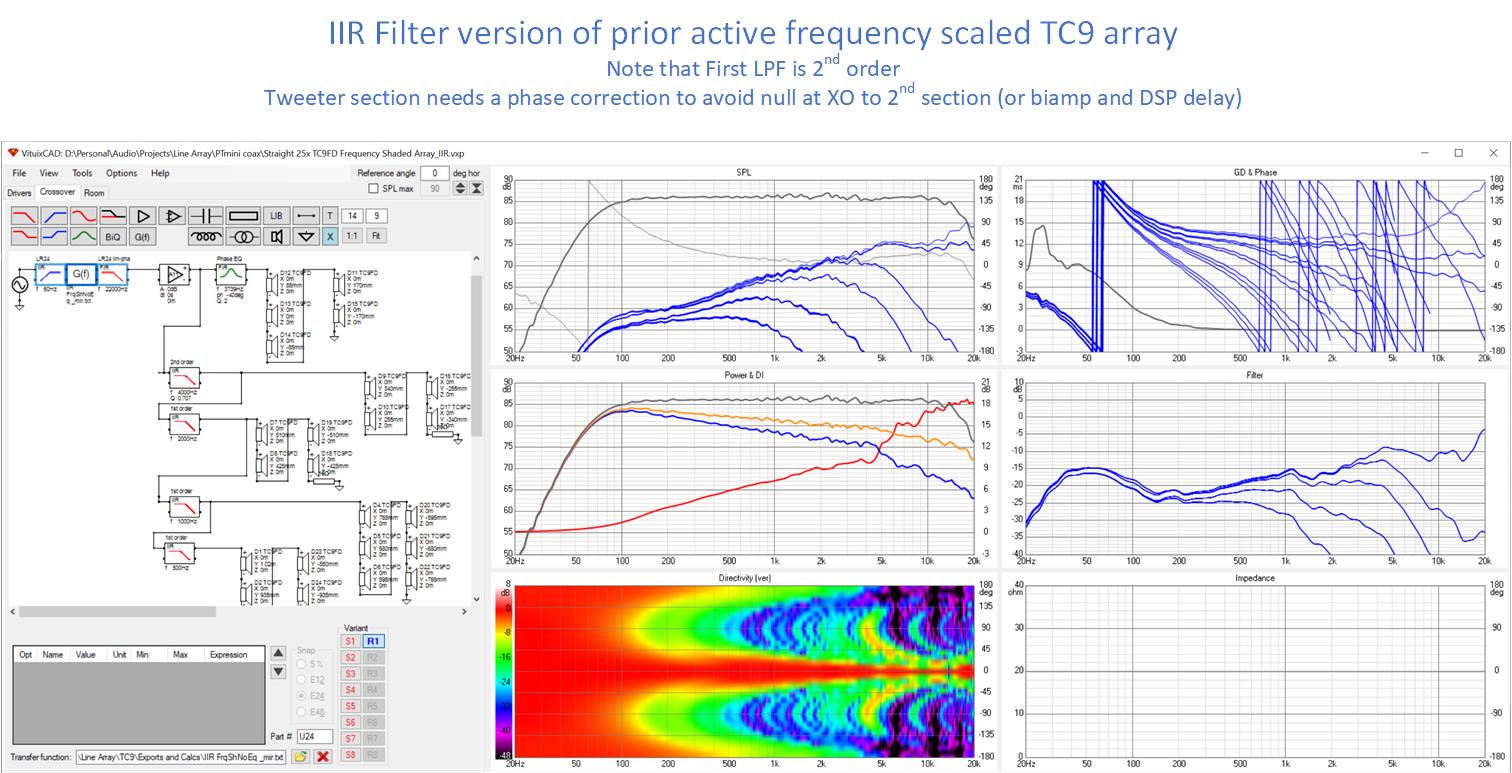
I can't find the sim this came from or I could say more about it. I did find a couple sims where I crossed to the tweeter at 6 khz and one where I simulated a brickwall filter. This latter was clearly not the way to go. Blending tweeter and waveguide makes a smoother transition to the tweeter's wider pattern and narrows the composite pattern.
I can't find the sim this came from or I could say more about it. I did find a couple sims where I crossed to the tweeter at 6 khz and one where I simulated a brickwall filter. This latter was clearly not the way to go. Blending tweeter and waveguide makes a smoother transition to the tweeter's wider pattern and narrows the composite pattern.
Attachments
I've spend a lot of time to get it narrow enough, but still keep the standing position.
There's only so much we can do, especially with passive components.
Even though the graphs on the proposal from ra7 look better in terms of DI index, the floor/ceiling influence is bigger than on my shelf shaded proposal.
My preference goes to the shelf shading in this case, as it has the most chance of working with the room. At least in my room. Plus I like the shared load better than one driver working real hard to keep up. The compromise mostly is top end performance above 10 KHz. But compared to the unshaded there should be a noticeable improvement, at least on paper. The factor that got me willing to try it is that there is a chance of improvement all across the board down to 200 Hz.
I love juxtoposing your comment about how there is only so much we can do with passive components with the several threads in which noted designers claim there is no advantage to DSP in crossovers.
I wouldn't worry about a tweeter in a waveguide. You would use a tweeter with >=100W power handling. It would have some horn gain and it would not need line array roll off compensation, although it might need controlled directivity waveguide compensation.
I hear you about the room. I have not completely beaten my rooms into submission but nevertheless, I prefer not have to completely redesign and rebuild my arrays, as does my wife even more so. Don't mind a little rewiring....
Wow, so many posts, where to begin?
Maybe... maybe not. I will be in the nearfield and there will be subs for the lows. Good quality woofers abound. SB Acoustics has some excellent options.
Interesting, did not know that!
Yeah, thankfully, I have a separate room though it is not as big as the basement I had three years ago. I just put together these speakers because I had the boxes from three years ago and the drivers. The top end was the massive Inlow tractrix horns, which were damaged in travel. So, I bought the 2380s, and what a combination that turned out to be!
The space saving feature of the arrays is a pretty important thing. I think both of you should try out a tweeter, even with the full array, just to see what it does. For me, it was a revelation. I always wanted to do the array with smaller elements, but a single tweeter is the next best thing. I tried a small tweeter array as well, but it did not work.
Ah, thank you for that!
I don't think floor bounce is a problem in the HF once the reflection arrives after 5 cycles. The ear would just ignore it. If this were a problem, everything from the Revel Ultima Salon's would have a problem.
I have no trouble at all with the 2380 horns. The midbass and upper bass is so much better on the arrays. In fact, if you just take the sound and not the imaging, the arrays are superior. They have a lot more definition and clarity, and the sounds have a sort of purity and authenticity. But, man, the imaging adds so much emotional impact.
Yes, the tweeter actually does not need the boost, like the arrays do. You have to pick an efficient tweeter that can take some power and then put it in a waveguide. I was using the Fountek Neo CD 3.5 ribbon that has a horn on it. Its sensitivity is about 95 db/W. It matched very well with the array. It did turn to mud during certain crescendos (Bolero, etc.). It probably didn't like being operated with a 2nd order filter at 3 kHz. But a proper dome tweeter in a waveguide shouldn't have that problem.
It is the same as the MS-EQ you had suggested for the arrays with the little bumps at 1.6 kHz and so on. For the phase, having a constant phase delta of 45 deg makes a huge difference with the instrument layering and depth. I think I posted about it in Pano's shuffler thread.I would love to see the values used of both the EQ and phase tricks.
Wouldn't you be worried going to a small compact speaker to lose a lot in dynamics?
Maybe... maybe not. I will be in the nearfield and there will be subs for the lows. Good quality woofers abound. SB Acoustics has some excellent options.
The thing that worries me about those plans is the ruggedness of the tweeter. On Dunlavy's big WMTMW's the tweeter turned out to be the achilles' heel. Lots of reports of blown tweeters. So whatever you pick there must be capable enough. That's why I'm not ready to go all out in that direction and will stick to sharing the load on as many drivers as needed to make them have at least 15 dB head room over my desired output level.
Interesting, did not know that!
(that JBL setup has way more than that (lol))
I simply don't have the room to go with a horn setup free standing, at least not while I'm in a happy relationship. I've mentioned before, without any constraints big horns would be where I'd be at. Most probably with an array of low frequency drivers. Due to space (and relationship) concerns I'm milking out this array concept, and have no regrets so far.
Still adding to this post as I had written a lot more, like on the ambient setup. You're absolutely right on my reasons of including that, I'm trying to mimic a way better space that I have (and it works) as that "wet edge" makes it much more entertaining and holographic like. Together with mid side tweaks it becomes very entertaining! Without it, I could keep the imaging great, but with it, it has that true feel/thrill of being involved.
Yeah, thankfully, I have a separate room though it is not as big as the basement I had three years ago. I just put together these speakers because I had the boxes from three years ago and the drivers. The top end was the massive Inlow tractrix horns, which were damaged in travel. So, I bought the 2380s, and what a combination that turned out to be!
The space saving feature of the arrays is a pretty important thing. I think both of you should try out a tweeter, even with the full array, just to see what it does. For me, it was a revelation. I always wanted to do the array with smaller elements, but a single tweeter is the next best thing. I tried a small tweeter array as well, but it did not work.
Floor and ceiling reflections only affect the in-room response, the orange trace in the left middle graph. If you don't see an orange trace, you can enable it by right clicking in that graph and checking "show in-room response".
Ah, thank you for that!
On horns, I have to agree that if you have the space, they are the way to go. You need a really large horn to maintain vertical pattern control low enough to avoid a floor bounce null. And an even larger room to be able to pull the horns well out away from the walls.
The early loss of vertical pattern control was an issue with my synergy corner horns; the other was the midband narrowing because I omitted a secondary flare. But the listening experience was superb.
I don't think floor bounce is a problem in the HF once the reflection arrives after 5 cycles. The ear would just ignore it. If this were a problem, everything from the Revel Ultima Salon's would have a problem.
I have no trouble at all with the 2380 horns. The midbass and upper bass is so much better on the arrays. In fact, if you just take the sound and not the imaging, the arrays are superior. They have a lot more definition and clarity, and the sounds have a sort of purity and authenticity. But, man, the imaging adds so much emotional impact.
I think you are where I was on the expanding array before I put it aside. I got a nice response with a TC9 tweeter at center and then realized I needed a more robust device for the top frequency range. And robust tweeters do exist: e.g. SB29 @>100W.
Ideally you would use a tweeter in a waveguide shaped to match the TC9's horizontal directivity. With a bare tweeter, the horizontal pattern would never match the rest of the array. I never found one but realize now I could probably develop/model one in axidriver and it would likely reduce to an OS profile machined into the baffle. I think maybe if I had heard a refined array such as you are working on, I would have been more motivated to go further in that direction but I chose instead to pursue the frequency shaded array. It remains to be seen how much better a line array sounds with subtractive combining effects removed via fine frequency shading.
Yes, the tweeter actually does not need the boost, like the arrays do. You have to pick an efficient tweeter that can take some power and then put it in a waveguide. I was using the Fountek Neo CD 3.5 ribbon that has a horn on it. Its sensitivity is about 95 db/W. It matched very well with the array. It did turn to mud during certain crescendos (Bolero, etc.). It probably didn't like being operated with a 2nd order filter at 3 kHz. But a proper dome tweeter in a waveguide shouldn't have that problem.
Last edited:
Amazing that you whipped that out so quickly. Moving those drivers around in VituixCAD is slowwww. I'm not complaining though, what an amazing software and a gift to diyers.I was curious enough to try:
A quick try though with my own driver positions more or less...
The wavy orange in-room prediction shows it does suffer from some from floor and ceiling reflection (set at -6 dB for both here)...
The worry I would have is that the single tweeter is asked to do a lot!
I made the level the same as on my own sims. We see a 10 dB boost on the top end of the single tweeter, where my own sims show way less and the load is shared by 5 drivers.
This is where my sim is incomplete. One of my other sims had a low pass filter for all the TC9s and high-pass for the single TC9 at 2 kHz or so. If you did that, and instead of the TC9, you had a respectable tweeter with 92 db or so efficiency, you would be OK. The trick would be to get a smooth change in directivity from the TC9 to the tweeter. I bet these are the same trade-offs SpeakerDave went through when designing his expanding arrays.
Your DI curve looks excellent though! But to get there would require something better than a TC9 as tweeter.
(by the way, I only counted 23 drivers (lol))
LOL! You are right. I think I was playing around with different combinations and because I have 24 drivers, there is no perfect center. So, I was thinking of leave the top driver unwired.
I love juxtoposing your comment about how there is only so much we can do with passive components with the several threads in which noted designers claim there is no advantage to DSP in crossovers.
I wouldn't worry about a tweeter in a waveguide. You would use a tweeter with >=100W power handling. It would have some horn gain and it would not need line array roll off compensation, although it might need controlled directivity waveguide compensation.
I hear you about the room. I have not completely beaten my rooms into submission but nevertheless, I prefer not have to completely redesign and rebuild my arrays, as does my wife even more so. Don't mind a little rewiring....
The thing to remember is that we will pass the final measurement with passive components through DRC and magically all drivers will be phase aligned. So, even though I had the Fountek driver sticking out in front of the array, DRC magically made it appear as though it was in the same plane as the TC9s. There were possibly some reflections from it, though it wasn't too bad.
I was thinking of carving a little waveguide out of wood as well. But I definitely do not have the time for it. I have some Vifa XT25 on hand. That will be where I start.
With today's modeling programs (Autodesk's Fusion for instance) and tools like Ath4 it should be easy to design a fitting waveguide for a tweeter and have it printed with SLS printing through an online service. I've already used that many moons ago for my car.
As another option, there's a thread somewhere where there is a series of 3D models being made for popular tweeters. I'd say it should be doable for those with some 3D modeling skills to make it fit whatever you'd need. Open source Waveguides for CNC & 3D printing!
I'm not planning to go that route just yet. I have lots of small changes that I want to try and work out first and have been quite content with what I have achieved thus far. And I expect the shading to work quite well to make the array even more independent from the room, meaning I can comfortably go with single point measurements which always had the best results in imaging for me. I get what you mean by the emotional trigger that imaging can have. Bundling that with great overall tonality really is something else!
Especially with a good room ambience.
Even something as simple as changing (the frequency dependent) window settings within DRC is able to make a remarkable difference in imaging. Especially with the mid/side EQ and previously mentioned ambient addon combined. Though I'm not quite done with cross talk cancelation either, as that proved to be a worthy tool for imaging for movies and Home Theatre, played back with a phantom centre. The source material mixed for multichannel systems usually is more consistent i.m.h.o.
As another option, there's a thread somewhere where there is a series of 3D models being made for popular tweeters. I'd say it should be doable for those with some 3D modeling skills to make it fit whatever you'd need. Open source Waveguides for CNC & 3D printing!
I'm not planning to go that route just yet. I have lots of small changes that I want to try and work out first and have been quite content with what I have achieved thus far. And I expect the shading to work quite well to make the array even more independent from the room, meaning I can comfortably go with single point measurements which always had the best results in imaging for me. I get what you mean by the emotional trigger that imaging can have. Bundling that with great overall tonality really is something else!
Especially with a good room ambience.
Even something as simple as changing (the frequency dependent) window settings within DRC is able to make a remarkable difference in imaging. Especially with the mid/side EQ and previously mentioned ambient addon combined. Though I'm not quite done with cross talk cancelation either, as that proved to be a worthy tool for imaging for movies and Home Theatre, played back with a phantom centre. The source material mixed for multichannel systems usually is more consistent i.m.h.o.
I agree, 3D printing is a good way to go for small waveguides. That open source WG thread is where I got the directivity for my simulation experiment but only the H directivity is available.
This discussion inspired me. I was able to trace posted directivity for SEOS18 (and I do have a pair in storage so this isn't entirely theoretical for me) and did a simulation with them. The S18 is 166mm tall so for quick sim, I replaced the 3 center drivers of the 25x TC9 array with the SEOS18 and went to work.
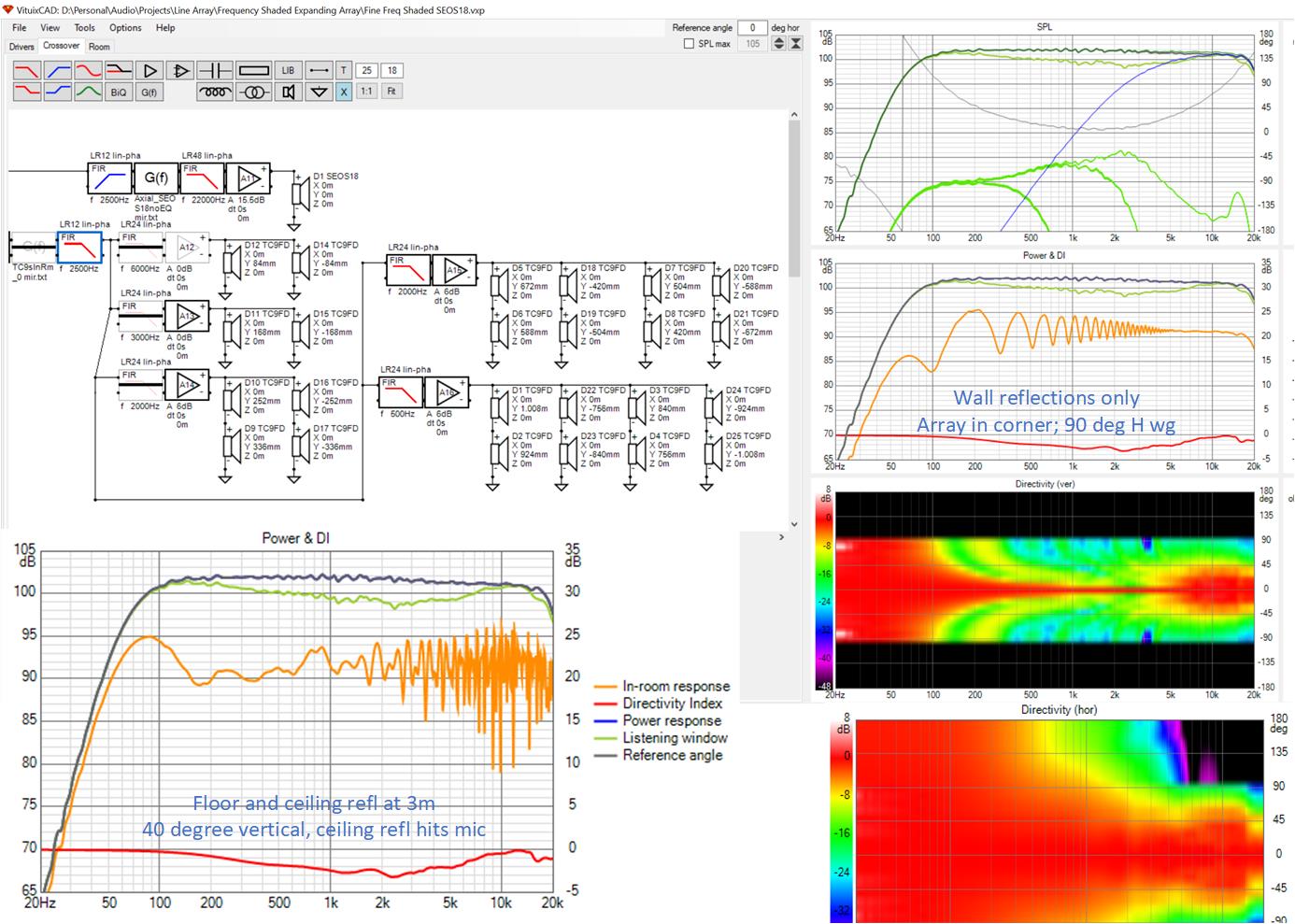
It didn't take much frequency shading to get a decent result. Crossover is at 2500 Hz because WG starts to widen vertically at 2 khz. Used low slope XO thinking overlap would help.
I equalized the axial response and then looked at the room response separately for wall and then for floor&ceiling reflections. Like any other speaker, one has to treat the first reflection points. This 90H WG in a corner keeps sound off the walls so above XO, wall combing disappears but its 40V directivity allows floor and ceiling bounce at 3m distance, much less at 2m given the geometry. So just like with the homogeneous array, there is benefit to floor and ceiling absorption in the treble.
One of the biggest concerns is keeping wg balanced with array over distance. This next plot shows the FR at double the distance, 6m. The axial response doesn't change much but the floor and ceiling support for the bass does, just like in the homogeneous array.
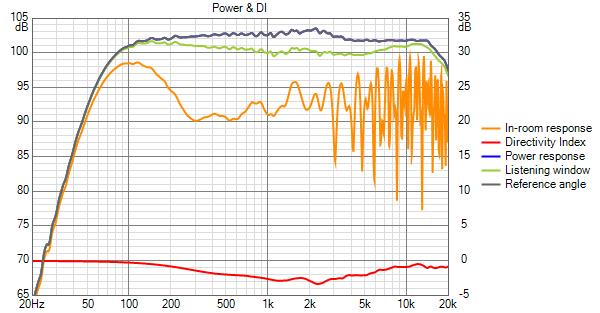
If you displace the mic vertically more than 200mm or so, the response falls apart at the XO because of the vertical directivity mismatch. No doubt a passive shelf shading approach like Wesayso uses that widens the array vertical directivity would help.
Well the SEOS18 is rather large for something like this but I am encouraged nevertheless. I also have a pair of SEOS12s and the SEOS family goes down to SEOS6. DIYSG has stock on SEOS8 dome tweeter waveguides for $17.
This discussion inspired me. I was able to trace posted directivity for SEOS18 (and I do have a pair in storage so this isn't entirely theoretical for me) and did a simulation with them. The S18 is 166mm tall so for quick sim, I replaced the 3 center drivers of the 25x TC9 array with the SEOS18 and went to work.
It didn't take much frequency shading to get a decent result. Crossover is at 2500 Hz because WG starts to widen vertically at 2 khz. Used low slope XO thinking overlap would help.
I equalized the axial response and then looked at the room response separately for wall and then for floor&ceiling reflections. Like any other speaker, one has to treat the first reflection points. This 90H WG in a corner keeps sound off the walls so above XO, wall combing disappears but its 40V directivity allows floor and ceiling bounce at 3m distance, much less at 2m given the geometry. So just like with the homogeneous array, there is benefit to floor and ceiling absorption in the treble.
One of the biggest concerns is keeping wg balanced with array over distance. This next plot shows the FR at double the distance, 6m. The axial response doesn't change much but the floor and ceiling support for the bass does, just like in the homogeneous array.
If you displace the mic vertically more than 200mm or so, the response falls apart at the XO because of the vertical directivity mismatch. No doubt a passive shelf shading approach like Wesayso uses that widens the array vertical directivity would help.
Well the SEOS18 is rather large for something like this but I am encouraged nevertheless. I also have a pair of SEOS12s and the SEOS family goes down to SEOS6. DIYSG has stock on SEOS8 dome tweeter waveguides for $17.
Attachments
I got the best vertical response with no shading and a lin phase LR8 XO at 1600 Hz
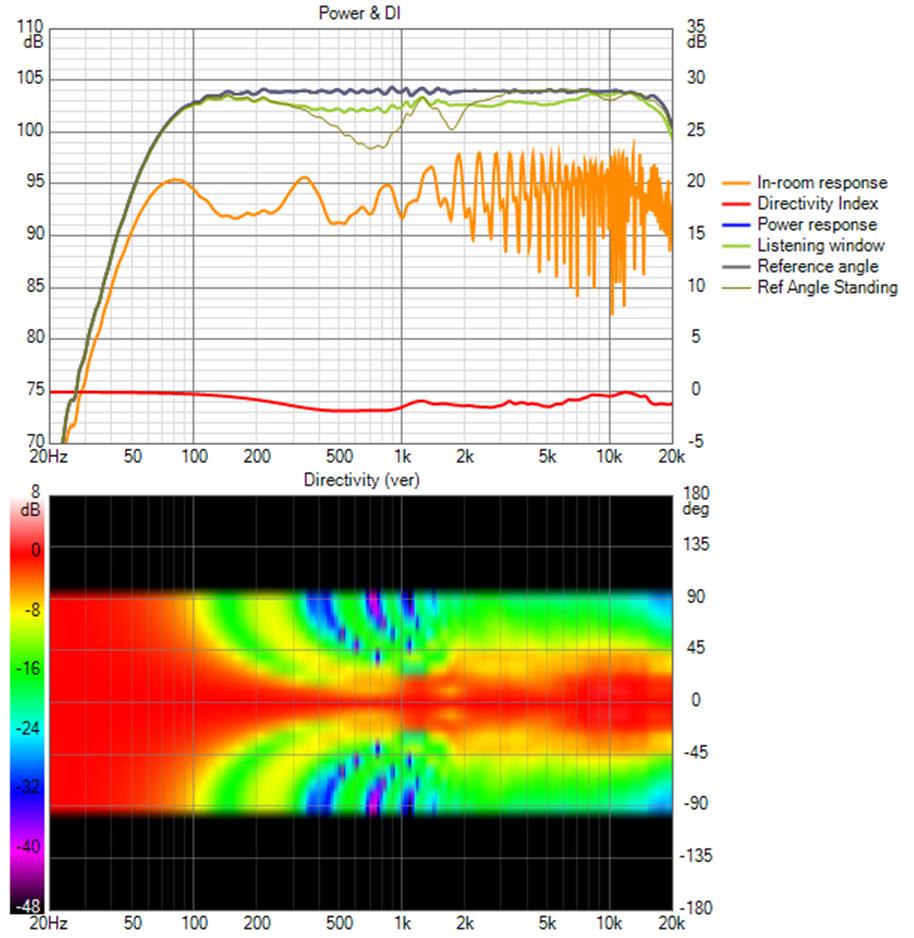
room response includes just floor and ceiling reflections at 3m and hasn't been equalized
Equalizing the room response at seated height:
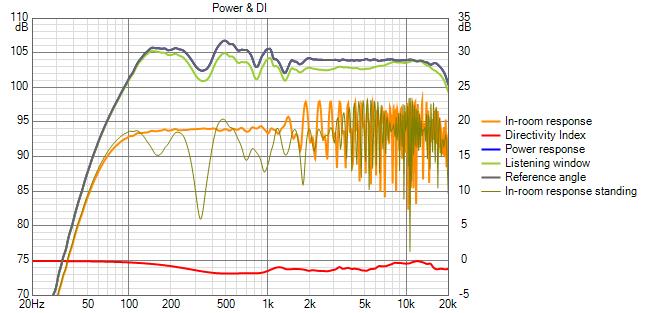
room response includes just floor and ceiling reflections at 3m and hasn't been equalized
Equalizing the room response at seated height:
Attachments
It makes me think the ideal solution would be a tall ribbon like tweeter on the top end to keep some of the (narrow) vertical directivity while horizontal would be less of a problem finding a similar pattern... frequency shaded it could turn out to be a winner...
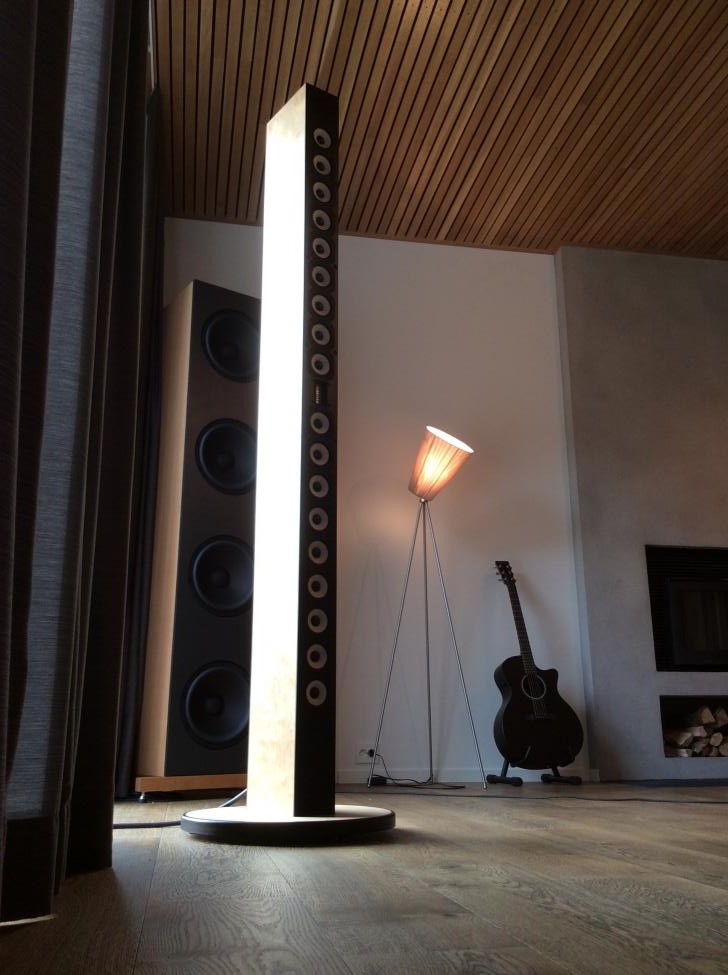
(much like Adyton used, such a tweeter has been on my mind a couple of times)
If you can avoid ceiling splash with the narrow directivity of such a tweeter you gain freedom where to cross it...
(much like Adyton used, such a tweeter has been on my mind a couple of times)
If you can avoid ceiling splash with the narrow directivity of such a tweeter you gain freedom where to cross it...
Attachments
Last edited:
Do you recall my postings back near the start of all this about Dayton PT-mini coaxial with TC9's? post 435
https://www.diyaudio.com/forums/full-range/337956-range-line-array-wall-corner-placement-44.html#post6188108
I didn't post the detail but I mentioned the concept which allows a ribbon like source as tall as desired, even floor to ceiling. The PTmini mounts to the front of the baffle and the TC9 behind on a one to one basis. The TC9 plays through a slot next to the mini that has almost the same dimensions as the radiating surface of the mini. IIRC, the horizontal CTC between drivers is about 20mm.
Its possible to model that ribbon center array you posted in Vituix. In Vituix diffraction tool, model the ribbon as a stack of thin horizontal slices whose width matches that of the ribbon's active surface, then link that to the axial response traced from the data sheet. You will still wonder how it sounds but at least you will have a good idea of how it will measure.
The problem with the SEOS18 is that the vertical pattern is 40 degrees. Sooner or later sound hits the ceiling and comes back down, even in the frequency range where the vertical pattern is controlled. That should be a familiar problem for anyone who has or had a conventional multi-way speaker. You may recall ra7 just said that the ceiling bounce would be delayed enough to be ignored by the ear. Perhaps so but my sims show ceiling bounce starting at or just before the 1600 hz XO frequency meaning outdoor measurements highly desirable for doing the xo
https://www.diyaudio.com/forums/full-range/337956-range-line-array-wall-corner-placement-44.html#post6188108
I didn't post the detail but I mentioned the concept which allows a ribbon like source as tall as desired, even floor to ceiling. The PTmini mounts to the front of the baffle and the TC9 behind on a one to one basis. The TC9 plays through a slot next to the mini that has almost the same dimensions as the radiating surface of the mini. IIRC, the horizontal CTC between drivers is about 20mm.
Its possible to model that ribbon center array you posted in Vituix. In Vituix diffraction tool, model the ribbon as a stack of thin horizontal slices whose width matches that of the ribbon's active surface, then link that to the axial response traced from the data sheet. You will still wonder how it sounds but at least you will have a good idea of how it will measure.
The problem with the SEOS18 is that the vertical pattern is 40 degrees. Sooner or later sound hits the ceiling and comes back down, even in the frequency range where the vertical pattern is controlled. That should be a familiar problem for anyone who has or had a conventional multi-way speaker. You may recall ra7 just said that the ceiling bounce would be delayed enough to be ignored by the ear. Perhaps so but my sims show ceiling bounce starting at or just before the 1600 hz XO frequency meaning outdoor measurements highly desirable for doing the xo
I'm just throwing out ideas that have crossed my mind at some point.
Like I said, not a route I'm going to follow soon. I've been content with what I have, but always up for an experiment that can be reversed .
.
If I can improve what I have I'd be happy and shocked at the same time.
Like I said, not a route I'm going to follow soon. I've been content with what I have, but always up for an experiment that can be reversed
If I can improve what I have I'd be happy and shocked at the same time.
That is what simulation is good for - you get a wild and crazy idea and with a modicum of effort, vou can tell if its worth pursuing.
I'm probably going to keep going until I come up with something that has good response both seated and standing.
I went back to the Expanding Array with SEOS18 today and made the array less like a line array and more like a Snell expanding array.
Here are the uncorrected room responses both seated ( 0 offset) and standing (-500 offset):
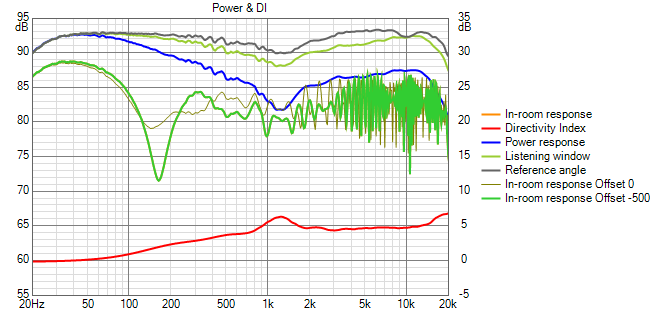
It was equalized for seating but standing response is pretty good except for the one floor/ceiling dip at the standing height. Axial shows a 3 db dip at XO but that is at standing. Its only 1 db when seated.
The next picture has all the details.
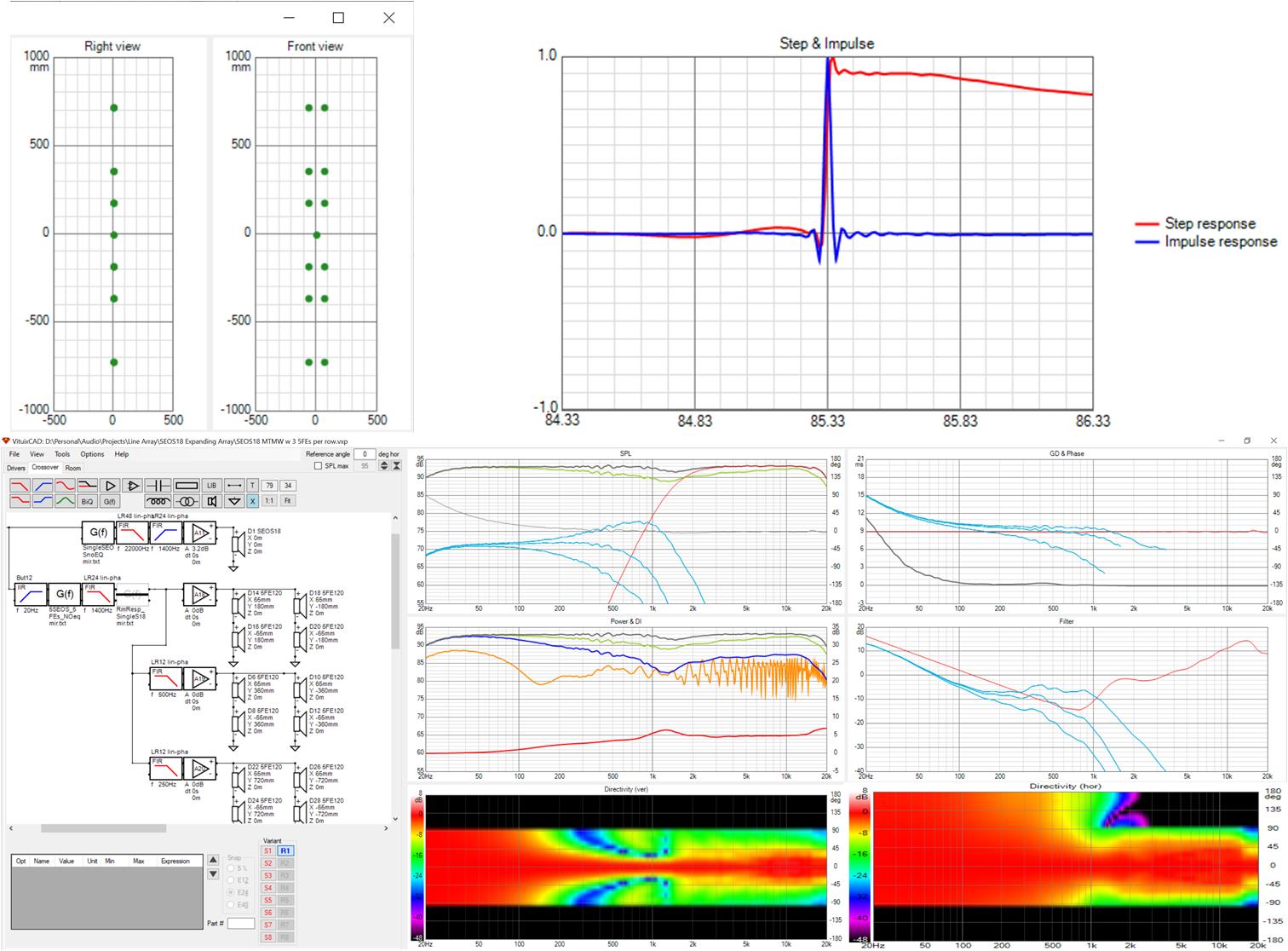
The driver layout is in the top left. The single driver at center is SEOS18 with BMS4550 CD. All other drivers are Faital 5FE120 midwoofers. There are enough of them to get down to 30 Hz but if anyone were to build this, I would recommend replacing the top and bottom pairs with something larger - like an AE TD15 for real authority.
Nothing to complain about in the impulse and step response.
At seated height, the dip at 1400 Hz XO is only 1 db. Originally at 2 khz XO there was no dip but the lower XO improves the directivity match between the array and the waveguide. I started with rows of 4 5FE120's but got the best horizontal match with only 2 per row
Above 2 khz, the directivity is all due to the waveguide. 2 Khz is where its vertical pattern starts widening, but the widening is controlled by blending it with the array, although blending is not very gradual - I'm using 4th order filter slopes. You will find linear phase filters on my schematic but aside from wanting flat phase, there is no reason why they couldn't be IIR or passive.
Snell et. al. would build something like this with a 4-way XO with a lot of engineering behind it to fine tune the directivity. Treating the woofers as an frequency shaded array allowed me to do this with only a simple 2 way XO and a couple of low pass filters.
I'm probably going to keep going until I come up with something that has good response both seated and standing.
I went back to the Expanding Array with SEOS18 today and made the array less like a line array and more like a Snell expanding array.
Here are the uncorrected room responses both seated ( 0 offset) and standing (-500 offset):
It was equalized for seating but standing response is pretty good except for the one floor/ceiling dip at the standing height. Axial shows a 3 db dip at XO but that is at standing. Its only 1 db when seated.
The next picture has all the details.
The driver layout is in the top left. The single driver at center is SEOS18 with BMS4550 CD. All other drivers are Faital 5FE120 midwoofers. There are enough of them to get down to 30 Hz but if anyone were to build this, I would recommend replacing the top and bottom pairs with something larger - like an AE TD15 for real authority.
Nothing to complain about in the impulse and step response.
At seated height, the dip at 1400 Hz XO is only 1 db. Originally at 2 khz XO there was no dip but the lower XO improves the directivity match between the array and the waveguide. I started with rows of 4 5FE120's but got the best horizontal match with only 2 per row
Above 2 khz, the directivity is all due to the waveguide. 2 Khz is where its vertical pattern starts widening, but the widening is controlled by blending it with the array, although blending is not very gradual - I'm using 4th order filter slopes. You will find linear phase filters on my schematic but aside from wanting flat phase, there is no reason why they couldn't be IIR or passive.
Snell et. al. would build something like this with a 4-way XO with a lot of engineering behind it to fine tune the directivity. Treating the woofers as an frequency shaded array allowed me to do this with only a simple 2 way XO and a couple of low pass filters.
Attachments
Last edited:
quite a bit. here is what Hdir looks like with 4 woofers per row
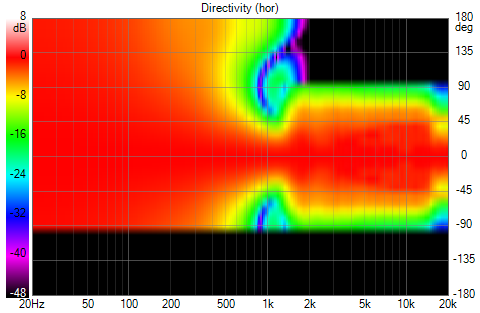
Its the narrowing directivity of the woofers meeting the expanding directivity of the waveguide. I imagine that if I went down to 4" woofers for the closest in row and got the spacing just right, I could have a smooth transition
Its the narrowing directivity of the woofers meeting the expanding directivity of the waveguide. I imagine that if I went down to 4" woofers for the closest in row and got the spacing just right, I could have a smooth transition
Attachments
Instead of the ribbon I suggested, I figured a solution like the Tecton speakers would also be a viable option for the top end. See this demonstration by Adason: https://www.diyaudio.com/forums/multi-way/356684-mtm-sound-characteristics-12.html#post6275701
It has even more options as one can play with vertical and horizontal dispersion separately from each other. Fully adjustable and not a single element that has all the load, but sort of an array that carries the load together.
The adjustability of such a group of drivers packed together should enable a good transition to the array.
It has even more options as one can play with vertical and horizontal dispersion separately from each other. Fully adjustable and not a single element that has all the load, but sort of an array that carries the load together.
The adjustability of such a group of drivers packed together should enable a good transition to the array.
- Home
- Loudspeakers
- Full Range
- Full range line array for wall or corner placement
